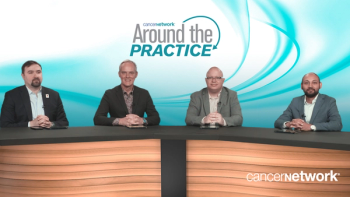Carl Ola Landgren, MD, PhD
Articles by Carl Ola Landgren, MD, PhD

Looking Ahead: Major Clinical Advancements in Myeloma From ASH 2024 and What’s to Come in 2025
ByLuciano Costa, MD, PhD,Bhagirathbhai Dholaria, MD,Carl Ola Landgren, MD, PhD ,Muhamed Baljevic, MD, FACP Panelists discuss key strides made in 2024, including exciting data presented at the 66th American Society of Hematology Annual Meeting and Exposition (ASH 2024), and reflect on pivotal developments, such as new insights into Bruton tyrosine kinase inhibitors, that are shaping clinical practice while looking ahead to 2025 with anticipation for continued advancements that will further enhance treatment strategies and patient outcomes.

Integrating Bispecific Antibodies Into Clinical Practice
ByLuciano Costa, MD, PhD,Bhagirathbhai Dholaria, MD,Carl Ola Landgren, MD, PhD ,Muhamed Baljevic, MD, FACP Panelists discuss how bispecifics, like teclistamab, are administered at their institutions, the monitoring of cytokine release syndrome (CRS) and immune effector cell–associated neurotoxicity syndrome (ICANS) during step-up dosing, and strategies to improve care transitions between academic centers and community practices. They also highlight the potential for outpatient administration of bispecifics, as seen in the OPTec and Ambulatory Teclistamab studies, emphasizing the benefits of patient convenience and safety.

Sequencing Bispecifics and BCMA-Targeted Therapies in R/R MM
ByLuciano Costa, MD, PhD,Bhagirathbhai Dholaria, MD,Carl Ola Landgren, MD, PhD ,Muhamed Baljevic, MD, FACP Panelists discuss how bispecifics are sequenced with other B-cell maturation antigen (BCMA)–targeted therapies, such as chimeric antigen receptor (CAR) T cells or antibody drug conjugates (ADCs), and whether early vs late relapse impacts treatment strategies for relapsed/refractory multiple myeloma (R/R MM), with emphasis on how biological and clinical factors influence decision-making.

Strategic Use of Bispecific Antibodies in R/R MM
ByLuciano Costa, MD, PhD,Bhagirathbhai Dholaria, MD,Carl Ola Landgren, MD, PhD ,Muhamed Baljevic, MD, FACP Panelists discuss at what line of therapy bispecific antibodies are considered in treatment decision-making, whether they are used earlier or later in the sequence, and the factors influencing that choice, including weighing bispecifics against other options like chimeric antigen receptor (chimeric antigen receptor) T or standard therapies. They also address the clinical and molecular factors that guide the selection between B-cell maturation antigen (BCMA)– and GPRC5D-targeting bispecifics and comment on the study exploring talquetamab as a bridging strategy before BCMA CAR T therapy, highlighting the potential impact of bispecifics in this treatment paradigm.

Bispecifics in R/R MM: Key Data and Clinical Implications From ASH 2024 and Ongoing Trials
ByLuciano Costa, MD, PhD,Bhagirathbhai Dholaria, MD,Carl Ola Landgren, MD, PhD ,Muhamed Baljevic, MD, FACP Panelists discuss how bispecific antibodies are reshaping the therapeutic approach in relapsed/refractory multiple myeloma (R/R MM), covering their mechanism of action, currently approved agents, and potential advantages. They explore how these therapies have transformed clinical decision-making, including optimal lines of therapy, patient selection, and best practices for integrating bispecifics into clinical practice.

Transplant-Ineligible NDMM: Updates from CEPHEUS and IMROZ at ASH 2024
ByLuciano Costa, MD, PhD,Bhagirathbhai Dholaria, MD,Carl Ola Landgren, MD, PhD ,Muhamed Baljevic, MD, FACP Panelists discuss recent data updates on transplant-ineligible and deferred newly diagnosed multiple myeloma (NDMM), including findings from the CEPHEUS and IMROZ studies, and explore the clinical significance of minimal residual disease negativity as a prognostic and actionable factor in treatment decision-making for NDMM.

AURIGA Trial Highlights: Daratumumab + Lenalidomide Maintenance in Newly Diagnosed MM
ByLuciano Costa, MD, PhD,Bhagirathbhai Dholaria, MD,Carl Ola Landgren, MD, PhD ,Muhamed Baljevic, MD, FACP Panelists discuss evolving approaches to maintenance therapy in newly diagnosed multiple myeloma, focusing on balancing survival benefits with tolerability. They also review the latest data from the AURIGA trial evaluating daratumumab and lenalidomide maintenance.

Tailoring Induction Therapy in Newly Diagnosed Transplant-Eligible MM: Key Considerations
ByLuciano Costa, MD, PhD,Bhagirathbhai Dholaria, MD,Carl Ola Landgren, MD, PhD ,Muhamed Baljevic, MD, FACP Panelists discuss the factors influencing the choice between isatuximab and daratumumab for induction therapy in transplant-eligible newly diagnosed multiple myeloma, as well as the role of dara-based quadruplet regimens as the standard of care and considerations for triplet regimens in specific patient populations.

Highlights from ASH 2024: Optimizing Frontline Therapy in Transplant-Eligible MM
ByLuciano Costa, MD, PhD,Bhagirathbhai Dholaria, MD,Carl Ola Landgren, MD, PhD ,Muhamed Baljevic, MD, FACP Panelists discuss recent clinical trial findings, including the PERSEUS, CASSIOPEIA, IsKia, and GMMG-HD7 studies, and how these evolving treatment strategies are shaping the approach to frontline therapy for patients with transplant-eligible multiple myeloma.




